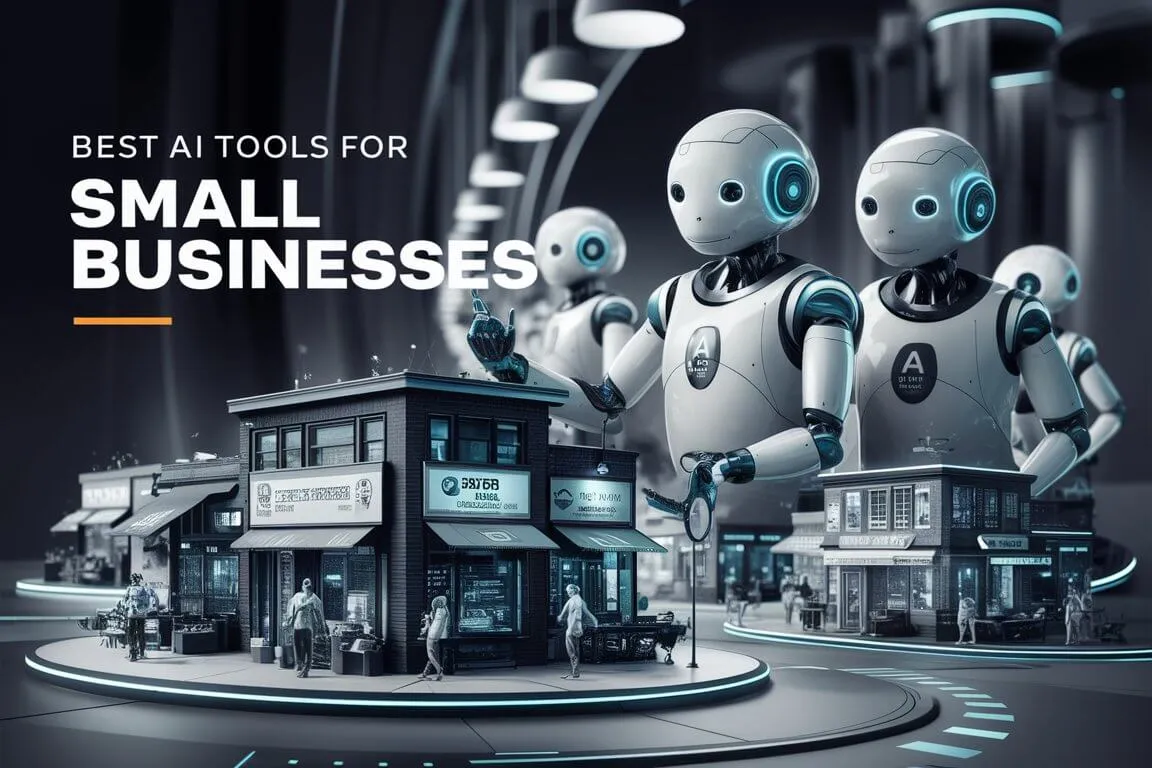Table Of Content
I've been doing digital marketing for over a decade. And let me tell you, things have changed. A lot!
The rise of AI has been mind-blowing. But the good thing - it's not just for the big players anymore. In 2024, AI tools are leveling the playing field for small businesses.
I remember the days of manually writing and scheduling social media posts at 2 AM and trust me, it wasn't fun. Now? AI does it while I sleep. And today, I’m here to share the secrets that have transformed my marketing strategy. I'll share the good, the bad, and the "wow, I wish I knew that sooner" tools. Keep reading if you don’t want to waste your time testing tools to find the top AI marketing tools.
Benefits of AI in Small Business Marketing
Before we jump into the tools, let's talk about why AI is such a big deal for us small business owners.
Time Savings
Remember spending hours on tedious tasks? AI tools cut that down to minutes.
In a survey, 52% of marketing professionals said the biggest benefit of AI is time-saving and efficiency of workflows. Two months ago, I had a product launch coming up. In the past, I'd block off a whole week just for creating content. This time, I used AI tools to generate social posts, email copy, and even video scripts in one afternoon.
The rest of the week? I focused on strategy and connecting with influencers. And as we launched - Zebracat was the Product Hunt’s #1 Product of the Day.

Personalization at Scale
80% of consumers are more likely to purchase from a brand that provides personalized experiences (Source). But how do you personalize for thousands of customers?
AI makes it possible. I've seen my email open rates jump from 15% to over 35% just by using AI-powered personalization. AI tools can analyze past behavior, purchase history, and even the time of day your customers usually open emails.
How? I’ll tell you how and the best tool to do this later in the article.
Improved Customer Support
AI chatbots (and now voicebots) have transformed customer service. 84% of customer service reps find AI makes it easier for them to respond to support tickets, according to this HubSpot blog post.
We now offer 24/7 support in some of our businesses without hiring a night shift. The best part? Customers often don’t care anymore that they're talking to a bot (some don’t even realize it’s a bot). Our satisfaction scores have never been higher.
Competing with the Big Guys
With AI, David can truly take on Goliath. I've seen small local businesses use AI tools to create marketing campaigns that rival national brands.
It's not about the size of your team anymore – it's about how smart your tools are. One example is GetTransfer, a Hong Kong-based service that expanded globally.
They improved their driver bidding system and automated various processes, such as email categorization and software testing. This internal development allowed the company to optimize pricing for drivers and improve service delivery.
Best AI Tools for Small Business Marketing in 2024
Now, let's examine the best AI marketing tools for small businesses that have been helpful for my business and many others I've worked with. Each of these tools has its unique strengths. I'll share my personal experiences, both good and bad.
1. Zebracat

As one of the team members of Zebracat, I've poured my heart and soul into creating a tool that solves real problems for small businesses. But I promise to give you an honest, warts-and-all review.
What Zebracat Does
Zebracat is an AI-powered video creation tool that turns text into engaging marketing videos in minutes. Think of it as your personal video production team, minus the hefty price tag.
Pros
- Efficient text to video creation
- User-friendly interface
- High-quality video output
- Time-saving: minutes instead of days
- Versatile for various marketing needs
Cons we’re working on:
- Occasional glitches in the system
- Limited advanced editing options
Personal Experience
We created Zebracat out of necessity. As a business owner, I was drowning in the time-consuming task of creating marketing videos. There had to be a better way. And we figured that out.
After automating the process for ourselves, we built this tool to save fellow marketers from the same headache. Now, anyone can turn text into professional videos in minutes.
It works like this:
- You paste in any text - blog posts, product descriptions, social media updates.
- Zebracat AI scans the text, creates a script, and generates a professionally designed video with integrated media.
- Videos adapt their runtime, visuals, music, and narrative flow automatically based on your input material.
The biggest benefit by far is the time and money Zebracat saves. Last month alone, I created over 30 data-driven product demo videos in just 2 days. Something that would have cost tens of thousands and weeks of production time in the past. Even better - engagement on those product pages went up over 50%.
But don't just take my word for it. We have a 4.7/5 rating on Trustpilot, 4.8/5 on Capterra, and 4.7/5 on G2. With 50,000+ marketers using Zebracat and 200K+ videos generated, Zebracat has proven to be a must-have for marketers.

One warning: Zebracat uses AI, not actual people, for the voiceovers. So while the 120+ voice options sound impressively human, occasionally you'll have some glitches. But no solution is perfect. Our dev team is working on more natural voices.
Pro Tip: Use Zebracat's "Brand Kit" feature to customize the tone of your videos.
2. HubSpot Marketing Hub

HubSpot's Marketing Hub is like that friend who seems to be good at everything. At first, it's intimidating. But once you get to know it? You wonder how you ever lived without it.
What HubSpot Marketing Hub Does
HubSpot Marketing Hub is an all-in-one platform that integrates AI across its key features. It uses artificial intelligence to enhance email marketing, assist content creation, optimize lead generation, and improve campaign performance. This AI integration aims to automate tasks and boost marketing effectiveness.
Pros
- Comprehensive lead generation and management tools
- Robust email marketing features
- Integrated social media management
- Effective A/B testing and automation workflows
- Detailed analytics and reporting
Cons
- Expensive, especially for smaller businesses
- Limited customization in some areas
- Integration gaps with certain tools
Personal Experience
My favorite feature is HubSpot's email marketing AI. Whenever I'm stuck on a subject line, I toss a few keywords into the AI Assistant which suggests catchy subject line options. Recently, one AI-generated headline got a 64% open rate - my best ever. Another lifesaver is the SEO optimization tool. I just plug in target keywords and the software analyzes hundreds of data points to recommend related topics my audience cares about. I constantly uncover awesome new blog post ideas I would never think of on my own.
Downsides? Hubspot ain't cheap. Their pricing makes the startup budget whimper. My advice is to start small with one or two tools you need most for now. You can always scale up as revenue allows.
Pro Tip: Hubspot offers great discounts for startups. If you’re eligible for these, avail the opportunity and enjoy the perks at a low price.
3. Copysmith AI

As someone who used to spend hours staring at a blank page, Copysmith AI feels like a superpower. Writer's block? What's that?
What Copysmith AI Does
It's an AI copywriting tool. It helps create various types of marketing content. We're talking ad copy, product descriptions, blog posts, you name it.
Pros
- Affordable AI writing solution
- Versatile content creation options
- High-quality output compared to competitors
- Excellent customer service
- User-friendly platform
Cons
- Occasional irrelevant or duplicate results
- Navigation can be confusing for new users
Personal Experience
When you're struggling with creative marketing copy, this tool works its magic. You feed it a few keywords and Copysmith's algorithms generate targeted headlines, meta descriptions, blog intros, or ad copy ideas in seconds. It also assesses the emotional sentiment of your copy and suggests tweaks to create stronger reactions.
Last month I used it to create a series of 950-character product page descriptions. I just entered the product name, features, and benefits for each. Copysmith compiled the details into compelling, on-brand descriptions in a fraction of the time I could have manually. But AI or not - quality still varies. I recommend reviewing Copysmith's suggestions with a critical human eye before publishing. Out of the 5 descriptions I created last week, I used 2 verbatim, edited 2 lightly, and rewrote 1 completely. So while it may not eliminate writer's block, Copysmith gives your brain the starting nudge it needs to get creative copy flowing.
4. Bardeen AI

Bardeen AI is designed to automate repetitive tasks and workflows. It integrates with various apps and services to help users streamline their daily activities.
What Bardeen AI Does
Bardeen AI aims to help users save time and focus on more critical work by handling the routine and repetitive tasks for them like data scraping, scheduling meetings, or sending notifications without requiring any code.
Pros
- No-code interface for easy automation
- Quick setup of complex workflows
- Practical for various business processes
- Regular updates and improvements
Cons
- Occasional bugs due to being a newer product
- Limited integrations with some major apps
- Learning curve for complex automations
Personal Experience
Bardeen AI is like a smart assistant who works behind the scenes in your digital systems to make things run more smoothly.
It creates automation between platforms and devices so tedious tasks take care of themselves. For example, Bardeen can:
- Pull contact details of people who download an eBook from your site and automatically add them as leads in your CRM.
- Sync new product listings from your e-commerce store into your email and social media platforms to promote.
- Monitor competitors' prices daily and notify you of changes so you can adapt instantly.
I personally use Bardeen to extract contact info for people who engage with my LinkedIn company page and add those leads directly into HubSpot for outreach. This gives me a steady influx of qualified leads without any actual work on my end. Bardeen is that lovely kind of AI.
It does have a learning curve though. I recommend starting with Bardeen's pre-built templates to see automation in action. I also had issues connecting it with some tools we use.
Pro Tip: Even the pre-built templates can often use a little optimization for your specific workflows. Don't be afraid to tweak them to your needs!
5. Hootsuite Insights

In the noisy world of social media, Hootsuite Insights is like having superhuman hearing. It cuts through the chatter to find what matters.
What Hootsuite Insights Does
It's an AI-enhanced social media analytics and listening tool. It helps you understand what people are saying about your brand online.
Pros
- Comprehensive social media monitoring
- Real-time data visualization
- User-friendly dashboard
- Valuable sentiment analysis feature
- Multi-channel tracking capabilities
Cons
- Overwhelming amount of data at times
- Occasional missed mentions
- Inaccuracies in sentiment analysis
Personal Experience
I have some really good experience with Hootsuite. Insights once detected a surge in negative comments about our new app update. Because it notified us so quickly, we rapidly updated the UX based on the feedback. Our next release had record downloads. We also use Insights to monitor competitors' social media campaigns. Once, it highlighted a creative giveaway boosting a rival's engagement. We adapted their idea for our own audience and saw 25% more signups than in past contests.
The downside?
The amount of data can be overwhelming. It took me a while to figure out which metrics really mattered for our business.
Pro Tip: Schedule regular Insights training so your full team can access the intel. Customize dashboards so each department - marketing, support, product - sees the most relevant data for them.
6. Persado

Persado AI assist sales teams in lead management. It identifies potential clients, enhances contact information, and tailors outreach efforts.
What Persado Does
It uses AI for language optimization in marketing messages. But here's the kicker: it focuses on emotional resonance. It's not just what you say, but how you make people feel.
Pros
- Subject lines categorized by emotion
- Insights on audience-motivating language
- Simplifies high-volume subject line writing
- Variety of emotional categories to choose from
- Improves email marketing effectiveness
Cons
- May require significant data for optimal results
- Similar outputs across different companies
Personal Experience
I just connect Persado to my email service or ads platform. As I draft campaigns, it suggests tweaks to elicit more positive emotional reactions from subscribers. For example, when promoting a recent sale, my initial email headline was:
"Our Biggest Sale of the Year!"
Persado alternatively suggested:
"Make Your Dreams Come True!"
Which sounds hyperbolic. But when I A/B tested both, the Persado email saw a 47% higher open rate.
Those behavioral psychologists inside Persado know exactly which emotional triggers motivate people. And the performance analytics are also detailed and actionable. It doesn't just tell you what worked, but why it worked. It's like having a marketing professor analyze every campaign.
Now I just write emails naturally, then use Persado's optimized suggestions to punch them up before sending. It's like an AI grammar checker - for feelings instead of commas.
However, Persado requires a significant amount of data to work effectively. In the beginning, when we had limited data, the results were less impressive.
Pro Tip: Give Persado lots of historical data on your previous campaigns so it can better optimize based on what resonates with your audience!
7. Albert AI

Albert is a cloud-based AI platform for digital marketers to manage and optimize paid ad campaigns. It supports major networks like Google, Facebook, Instagram, YouTube, and Bing.
What Albert AI Does
It offers AI marketing campaign management and optimization. It focuses on paid advertising channels. Think of it as your own personal ad manager who never sleeps.
Pros
- Self-learning AI technology
- Cross-channel campaign optimization
- Fast implementation process
- Personalized audience targeting
- Efficient long-tail search capabilities
Cons
- Requires digital advertising knowledge
- High initial investment
Personal Experience
Autonomous campaign management is a time-saver. It handles bid adjustments, budget allocations, and targeting optimizations across multiple platforms. It's like having a team of experts working around the clock.
After connecting Albert to my Google and Facebook accounts, I determined a monthly budget and let 'er rip. Now Albert autonomously shifts dollars between platforms and turns ads on or off based on performance data. Albert has decreased my cost-per-click by 36% in the past 3 months while still improving conversions by 19%. Set it and forget it.
My only gripe is Albert goes a bit rogue sometimes. I once woke up to find it had paused all my ads because performance dipped for a few hours the previous night. I prefer a bit more...oversight.
It also takes time for Albert to learn your business and preferences. The first month was a bit of a rollercoaster in terms of performance. But once it gets up to speed, it's like strapping a rocket to your marketing efforts.
Pro Tip: Set clear goals and constraints for Albert. The more specific you are about your objectives and limitations, the better it performs.
Read more on our blog about Best Faceless YouTube Channel Ideas in 2024.
Implementing AI Tools in Your Small Business Marketing Strategy
Now that we've talked about these powerful AI tools, let's see how to effectively integrate them into your marketing strategy. It's not just about having the tools - it's about using them right.
Assessing Your Current Marketing Needs and Challenges
Start by taking a close look at your current marketing efforts. Where are the bottlenecks? Which tasks are consuming most of your time?
For me, content creation was a major pain point. I was spending hours in video production and social media updates. That's why I started with AI video tools.
Ask yourself:
- What tasks do you dread doing?
- Where do you feel you're wasting time?
- What areas of your marketing need the most improvement?
Be honest with yourself. The goal is to find where AI can have the biggest impact.
Starting Small: Choosing the Right AI Tool to Begin With
Don't try to revamp everything at once. Pick one area where you're struggling the most and find an AI tool to address it.
When I first started using AI in marketing, I began with Zebracat for content and ad creation. The immediate time savings gave me the confidence to explore more AI tools.
Here's my approach:
- I listed my top 3 marketing challenges.
- I researched AI tools that could help with each.
- I chose the one that seemed easiest to implement.
Start small, see results, then expand. It's similar to learning a new skill - start with the basics before moving on to more complex techniques.
Integrating AI Tools with Your Existing Marketing Stack
Look for AI tools that work well with your current software. Most of the tools I've mentioned offer integrations with popular marketing platforms. For example, we integrated Zebracat with our social media management tool, allowing us to create and schedule video content in one smooth process.
Pro tip: Make a list of all the marketing tools you currently use. Then, when considering an AI tool, check its integration capabilities.
Training Your Team to Work Alongside AI Tools
Keep in mind, AI is here to support your team, not replace them. Invest time in training your staff to effectively use these tools.
We have a "Tech Tuesday" where we spend an hour exploring a new AI tool feature. It keeps everyone engaged and up-to-date.
Some ideas for training:
- Create simple tutorial videos for each tool.
- Have team members "teach" a tool to others.
- Set up a chat channel for sharing AI tips and tricks.
The key is to make it engaging and interactive. AI should be viewed as a helpful colleague, not a threat.
Start Using AI to Stay Competitive in 2024 and Beyond
The future of small business marketing is closely tied to AI. By adopting these tools now, you're not just keeping pace with the competition – you're setting yourself up to lead the pack.
From my years of experience in this field, I can confidently say that the businesses that thrive in the coming years will be those that enhance marketing with AI.
Keep in mind, the key is to start small, experiment often, and always keep your customers at the center of your strategy. AI is a powerful tool, but it's your unique brand voice and connection with your audience that will drive your success.
Here's my challenge to you:
Pick one AI tool from this list. Just one. Try it out for a month. See how it changes your marketing game. I think you'll be amazed at the results.
Remember, the future of marketing is powered by AI, but driven by humans. Let's make it extraordinary.
Create videos 10x faster and easier with Zebracat
Try it now









Comments